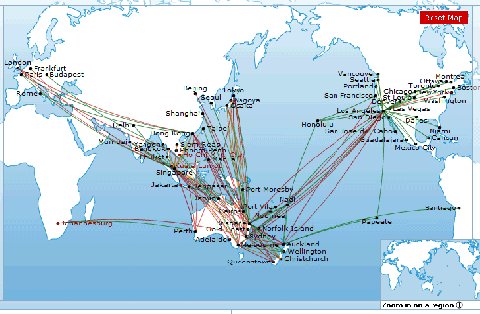I’ve spoken before about the on-going Jetstarisation of Qantas and despite Alan Joyce’s previous comments to the effect that there would be no further “jetstarisation,” recent developments certainly seem to indicate that this is not the case. We’ve previously joked about Jetstar taking over at Qantas and have occasionally used the phrase:
Qantas, a member of the Jetstar group
While this is a joke comment and I very much doubt we’ll ever see the reality officially recognised like this, recent actions and statements from the Qantas group have led me to coin the phrase:
If it’s new, it’s JQ!

Jetstar iPad image supplied by Jetstar
The first and most obvious indicator that Jetstar is where the action is relates to the introduction of an
iPad trial on Jetstar flights. Most reports have been gushing about the cool factor or the chance to do away with bulky in flight entertainment (IFE) systems. Others have questioned how they’ll prevent theft, how they’ll recharge and/or restock content and how long that 10 hour battery life will actually last when showing movies after multiple re-charge cycles.
No one, however, appears to have asked the obvious question:
Why is this trial being run on the cut-price, budget, no frills Jetstar brand instead of on a Qantas branded flight?
Is it because people are used to paying for IFE (indeed, anything!) on Jetstar so shelling out $10 wouldn’t be questioned as it might by those who are expecting more for their higher ticket price? Is it because Qantas are trying to associate “cool” with Jetstar? Is it because it’s easier to get Jetstar staff to trial new systems because it doesn’t have to be leveraged into a complex work agreement?
For whatever reason, it seems odd that something new, innovative and generally perceived as “cool” is being run on Jetstar. Maybe it’s because the bulk of the future growth within the Qantas group is going to be in Jetstar, so it’s better to trial this technology in the conditions it’s most likely going to encounter.
Perhaps a more blatant indication of the expansion of Jetstar compared to Qantas mainline is its encroachment on international routes. Qantas have said that they will use Jetstar on routes that do not have the margin to support a mainline service. Given the trend towards low price & discount operations, this can only mean that the Orange Star will be seen more & more around the world instead of the Flying Kangaroo.

Qantas route Map from AirlineRouteMaps.com
A prime example of this is the
expansion of Jetstar’s international routes out of Singapore and the increase in pilots they’re basing at Singapore & Auckland. Rather than basing pilots in Australia for flights into Europe, Jetstar are basing them in Singapore where they’ll fly on to Europe while Australian based pilots fly to & from Singapore (and probably no further). Jetstar pilots based in Singapore are apparently paid more than those based in Australia but even so, they’re paid significantly less than Qantas mainline pilots.
With the increase in pilots based in New Zealand (where they’re paid much less money than those based in Australia), it is also likely that more international routes will have crews from New Zealand flying into Australia and then on to the USA, Japan or Singapore as well as the increase in direct international flights from New Zealand.
Naturally the use of pilots based outside of Australia has raised the ire of the Australian & International Pilots Association (AIPA), the union that represents both Qantas mainline and Jetstar pilots. They’re up in arms about lack of consultation and using offshore based pilots to avoid Australia’s employment laws.
Again, no one has commented on the fact that increased use of Jetstar pilots on international routes means no expansion of Qantas mainline pilots and, in fact, fewer mainline pilots in the future if more routes transition to Jetstar.
As if all this wasn’t enough, Emirates have purchased more A380s which can only mean a significant increase in capacity out of Australia. Given the competition that Qantas faces from Emirates with their extremely discounted airfares (not to mention their levels of service, especially in the premium market) it is likely that more & more passengers from Australia will use Emirates for their flights to Europe. This in turn will put more pressure on Qantas to use Jetstar where possible, further increasing the likelihood that we’ll one day see a long haul A380 with Jetstar colours and seating arrangements.

You know it’ll happen sooner or later…
While Alan Joyce indirectly acknowledged Emirates’ growth when he recently announced that Qantas mainline services were seeing an increase in traffic, he fobbed off Emirates by saying that the Middle East was an unprofitable growth area that Qantas are not interested in. This statement makes it seem like Middle Eastern carriers are only taking people to their home bases which, unfortunately for Qantas, is clearly not the case. These carriers are offering faster, cheaper & better quality services to most points of Europe with a single stop over. To counter act this, Qantas are trying to open up more direct flights out of Singapore via Jetstar to compete on price & flexibility with the Middle East carriers. Yet again more growth in Jetstar and not in Qantas mainline.
If trends like these continue, I expect you’ll be hearing “Jetstarisation” crop up again & again. You’ll certainly be hearing us saying “If it’s new, it’s JQ!” more often. Just remember, you heard it here first :)


If it’s New, it’s JQ!
I’ve spoken before about the on-going Jetstarisation of Qantas and despite Alan Joyce’s previous comments to the effect that there would be no further “jetstarisation,” recent developments certainly seem to indicate that this is not the case. We’ve previously joked about Jetstar taking over at Qantas and have occasionally used the phrase:
While this is a joke comment and I very much doubt we’ll ever see the reality officially recognised like this, recent actions and statements from the Qantas group have led me to coin the phrase:
Jetstar iPad image supplied by Jetstar
No one, however, appears to have asked the obvious question:
Why is this trial being run on the cut-price, budget, no frills Jetstar brand instead of on a Qantas branded flight?
Is it because people are used to paying for IFE (indeed, anything!) on Jetstar so shelling out $10 wouldn’t be questioned as it might by those who are expecting more for their higher ticket price? Is it because Qantas are trying to associate “cool” with Jetstar? Is it because it’s easier to get Jetstar staff to trial new systems because it doesn’t have to be leveraged into a complex work agreement?
For whatever reason, it seems odd that something new, innovative and generally perceived as “cool” is being run on Jetstar. Maybe it’s because the bulk of the future growth within the Qantas group is going to be in Jetstar, so it’s better to trial this technology in the conditions it’s most likely going to encounter.
Perhaps a more blatant indication of the expansion of Jetstar compared to Qantas mainline is its encroachment on international routes. Qantas have said that they will use Jetstar on routes that do not have the margin to support a mainline service. Given the trend towards low price & discount operations, this can only mean that the Orange Star will be seen more & more around the world instead of the Flying Kangaroo.
Qantas route Map from AirlineRouteMaps.com
With the increase in pilots based in New Zealand (where they’re paid much less money than those based in Australia), it is also likely that more international routes will have crews from New Zealand flying into Australia and then on to the USA, Japan or Singapore as well as the increase in direct international flights from New Zealand.
Naturally the use of pilots based outside of Australia has raised the ire of the Australian & International Pilots Association (AIPA), the union that represents both Qantas mainline and Jetstar pilots. They’re up in arms about lack of consultation and using offshore based pilots to avoid Australia’s employment laws.
Again, no one has commented on the fact that increased use of Jetstar pilots on international routes means no expansion of Qantas mainline pilots and, in fact, fewer mainline pilots in the future if more routes transition to Jetstar.
As if all this wasn’t enough, Emirates have purchased more A380s which can only mean a significant increase in capacity out of Australia. Given the competition that Qantas faces from Emirates with their extremely discounted airfares (not to mention their levels of service, especially in the premium market) it is likely that more & more passengers from Australia will use Emirates for their flights to Europe. This in turn will put more pressure on Qantas to use Jetstar where possible, further increasing the likelihood that we’ll one day see a long haul A380 with Jetstar colours and seating arrangements.
You know it’ll happen sooner or later…
While Alan Joyce indirectly acknowledged Emirates’ growth when he recently announced that Qantas mainline services were seeing an increase in traffic, he fobbed off Emirates by saying that the Middle East was an unprofitable growth area that Qantas are not interested in. This statement makes it seem like Middle Eastern carriers are only taking people to their home bases which, unfortunately for Qantas, is clearly not the case. These carriers are offering faster, cheaper & better quality services to most points of Europe with a single stop over. To counter act this, Qantas are trying to open up more direct flights out of Singapore via Jetstar to compete on price & flexibility with the Middle East carriers. Yet again more growth in Jetstar and not in Qantas mainline.
If trends like these continue, I expect you’ll be hearing “Jetstarisation” crop up again & again. You’ll certainly be hearing us saying “If it’s new, it’s JQ!” more often. Just remember, you heard it here first :)
Related Posts: